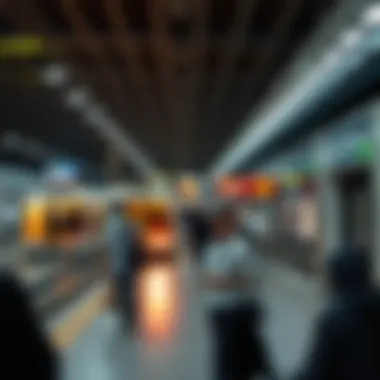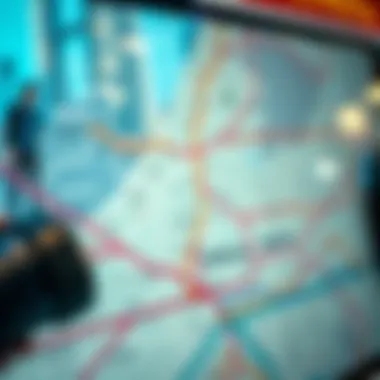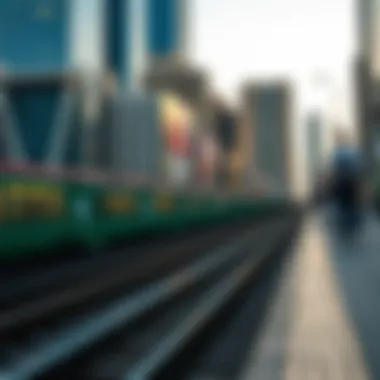Navigating Dubai's Metro Opening Times: A Guide


Intro
Navigating the bustling cityscape of Dubai can often feel like a chess game, especially if one's aim is to make informed decisions about real estate investments. A foundational piece in this puzzle is understanding the metro system's operating hours. Knowing when the trains are running can heavily influence how potential homebuyers or investors assess the value of properties nearby metro stations.
In recent years, the Dubai Metro has undergone significant changes in its operational timelines, including variations across different days of the week and even seasonal adjustments. Understanding these patterns not only aids commuters in planning their journeys, but also has far-reaching implications for investors and real estate enthusiasts. In this article, we aim to dissect metro opening times, revealing deeper insights into how they shape property accessibility and overall living conditions in the city.
This exploration will not only highlight the current landscape but will also offer a glimpse into market trends and potential future shifts that could affect property values. By the end, readers should have a well-rounded understanding of how the metro's operational schedule can directly impact choices in the housing market.
Market Trends and Insights
Current Market Analysis
Dubai's real estate market is in constant flux. Investors are regularly on the lookout for areas that promise high returns or steady growth. The proximity to metro stations is a key factor in this equation. Properties that lie within walking distance of metro stations tend to command higher prices due to the convenience they offer potential renters and buyers. Data indicates that areas around the Burj Khalifa and Deira witness a significant premium in property prices, largely owing to their accessibility via the metro.
Furthermore, as the city's population continues to expand and public transport becomes more integrated into daily life, understanding the timing of metro operations becomes a crucial part of a savvy investor's toolkit. The operating hours often coincide with peak commuting times, meaning properties near metro stations are expected to be in high demand, particularly during the weekdays.
Historical Trends and Future Predictions
Historically, Dubai’s metro has adapted its operational hours to align with both local culture and international standards. For instance, the metro opens earlier during holidays or peak tourist seasons. This trend raises questions about future adjustments. As the city gears up for larger events, such as World Expo 2025, investors should keep a keen eye on how the metro’s schedules might evolve.
Overview of Dubai's Metro System
Dubai's metro system represents not just a mere mode of transportation, but a significant component of the city’s urban infrastructure. The metro serves as an essential transit medium in a rapidly growing metropolis known for its towering skyscrapers and vibrant lifestyle. Understanding the metro system is vital for anyone who wishes to navigate the city effectively, including investors, realtors, homebuyers, and developers.
The metro in Dubai fundamentally reshapes the urban landscape by connecting various neighborhoods and economic hubs. This connectivity has far-reaching implications, especially for real estate. When investors consider properties close to metro stations, they often realize higher demand and increased property values, enhancing their potential returns.
History of the Metro
Dubai's metro journey began in 2006 when the first line, the Red Line, was officially inaugurated. Unbelievable as it may sound, just a short while ago, the concept of public transportation in Dubai was limited. With a growing population and increasing traffic congestion, the need for an efficient public transport system was painfully clear. The vision of the metro was to alleviate this congestion and promote the reduction of road traffic, ultimately positioning Dubai amongst the world's avant-garde cities.
Fast forward to today, and the metro has not only fulfilled its initial objectives but has also become a centerpiece of the city's public transport system. The metro now covers extensive areas, creating a seamless travel experience for both residents and tourists alike.
Metro Lines and Stations
The Dubai metro system consists of two primary lines, the Red Line and the Green Line. The Red Line stretches from Rashidiya to UAE Exchange, while the Green Line connects Dubai Creek to Al Jaddaf. Both lines intertwine at several transfer stations, making it easy for commuters to switch from one line to another, thus simplifying access to major attractions, business centers, and residential areas.
There are currently over 50 stations combined between the two lines, which not only reflect an impressive engineering feat but are also designed with aesthetics in mind. Many stations feature artworks and offer various amenities that enhance the commuter experience.
"The development of Dubai's Metro system has not just transformed travel; it has also sparked an unprecedented boom in property investments near its routes, reflecting the city's dynamic growth."
Moreover, with expansions planned, including future lines and additional stations, the metro is set to accommodate Dubai’s steadfast growth trajectory and ensure that investors keep an eye on properties with proximity to metro stations. Thus, understanding the metro's operational framework, including its history and layout, is imperative for informed decision-making regarding real estate investments in Dubai.
Metro Opening Times
Understanding metro opening times is crucial for anyone navigating Dubai's public transport system, especially for investors, realtors, homebuyers, and developers. The metro serves as a lifeline for daily commuters and tourists alike, enabling seamless travel across the Emirates, and knowing the operational hours can significantly affect your journey and, ultimately, real estate decisions.
Being aware of when the metro operates helps in several ways:
- Planning Arrangements: Commuters can avoid peak hours, thus reducing travel time and enhancing efficiency.
- Investment Decisions: For developers, proximity to metro stations can bolster property values, making it essential to understand opening times and patterns.
- Logistical Support: Companies can better manage employee transportation needs, ensuring that everyone arrives on time.
Moreover, special occasions and changes throughout the year can impact hours, so staying updated on these variations is important for smooth travel.


Standard Operational Hours
Dubai Metro typically runs throughout the week with well-defined standard operational hours. For the Red Line and Green Line, the general schedule is as follows:
- Saturday to Wednesday: Operates from 6:00 AM to 12:00 AM (midnight)
- Thursday: Extended hours from 6:00 AM to 1:00 AM (the following day)
- Friday: Metro runs from 8:00 AM to 1:00 AM (the following day)
These hours ensure that commuters have access to the metro for both early morning and late-night travel needs. Such accessible transit makes urban life in Dubai manageable and improves overall connectivity.
Weekend and Holiday Variations
When it comes to weekends and holidays, it is vital to recognize that varying schedules apply. During public holidays like Eid or National Day, the metro may alter its operational hours, often extending service to accommodate more passengers.
For example, during Eid al-Fitr, the metro usually operates longer hours, which allows residents and tourists to partake in celebrations without worrying about transport limitations.
Planning ahead is prudent. Those wishing to travel during these festive periods should check the official Roads and Transport Authority (RTA) website for the most accurate and updated information on opening times.
Consider this: Knowing when the metro is busiest can be just as important as knowing its schedule. By timing your travel around peak congestion, you can ensure a smoother commuting experience, avoiding the hassle of crowded trains.
Seasonal Changes in Metro Timings
Understanding how metro opening times in Dubai shift with the seasons is crucial for anyone who relies on this transit system, especially real estate investors, realtors, and commuters alike. These fluctuations can have a significant impact on daily routines, property values, and overall accessibility to various neighborhoods and attractions.
Adjustments During Ramadan
As a month of fasting and reflection, Ramadan introduces a unique set of operational changes for public services in Dubai, including the metro. During this period, the metro's operational hours extend to accommodate the cultural practices of the population. Typically, the metro opens later in the morning and stays operational longer into the night.
For instance, usual morning hours might shift from a standard 6 AM opening to around 10 AM. This adjustment acknowledges that many people will begin their days later due to the fasting schedule. Evening timings can also be inspired by local customs; operations often continue until around 2 AM to cater to residents who break their fast and wish to travel late into the night. This flexibility illustrates a broader acceptance of cultural nuances within public transport, making it more accommodating for all commuters.
Investors should remain aware of these time changes, as they can influence foot traffic in business districts. There may be a noticeable uptick in late-night shopping or dining, allowing businesses in proximity to metro stations to thrive during Ramadan evenings.
Summer Schedule Changes
Dubai's searing summer temperatures also bring about necessary adjustments to metro timings. Generally, the summer months see a consolidation of opening hours. A typical summer approach might involve a slight modification where the metro opens a bit earlier, around 5:30 AM, allowing early risers to start their day before the weather becomes too oppressive. Closing times might also vary, sometimes wrapping up service around midnight instead of the usual 1 AM.
This change is not simply a matter of comfort; it also impacts users' decision-making when scheduling their activities. For those considering investment near metro routes or planning real estate developments, understanding these temporary schedules is essential. Accessibility during these months could dictate potential returns on investment based on commuter patterns and general usage of the metro.
It's important to remember that changes in metro timings do not just reflect a response to cultural or climatic conditions but are also a key factor in shaping urban mobility trends in Dubai.
By keeping an eye on these seasonal timings, investors can strategize better regarding which areas may see more movement and what kind of developments could be beneficial in these circumstances. The synergy between transit times and urban activity underscores the interdependence of real estate and public transportation systems in a vibrant city like Dubai.
Commuting Insights
Understanding commuting insights is critical for anyone who uses or considering the metro system in Dubai, especially for investors, realtors, homebuyers, and developers. As the city continues to expand, the metro plays a crucial role in connecting various neighborhoods and business districts. Commuting insights reveal how metro opening times can significantly impact daily commutes, economic opportunities, and real estate investments. Discerning these insights enables stakeholders to make informed decisions regarding property investments in close proximity to metro stations.
Impact of Opening Times on Daily Commute
Metro opening times are not just numbers on a schedule; they are pivotal in shaping daily routines for numerous commuters. A late start might mean missing peak hours, which generally translates to a less crowded and quicker travel experience. Conversely, beginning a journey just as the workday ends may lead to sardine-like conditions on trains.
Consider the impact of a 10-minute difference in starting hours. For an individual traveling from a residential area to a business hub, adjusting their departure time can either alleviate or exacerbate stress during the commute. Factors such as these underscore the importance of being aware of the metro's operational hours and their relationship with traffic patterns.
Furthermore, the link between timing and commuter satisfaction cannot be overlooked. For example, studies show that metro timings which cater to early birds or night owls can enhance the overall experience, leading to increased reliance on this mode of transport. Commuters can optimize their time by aligning their schedules with the metro's best service intervals, thus turning arduous commutes into manageable ones.
Best Times to Travel


Determining the best times to travel on the metro can mean the difference between a serene ride and a chaotic rush hour. Generally, commuting during non-peak hours, typically mid-morning or early afternoon, is recommended.
- Morning Peak Hours: 7 AM - 9 AM
- Evening Peak Hours: 5 PM - 7 PM
- Off-Peak Hours: 10 AM - 4 PM; After 8 PM evenings
Traveling during off-peak hours can lead to less crowded trains, allowing for a more comfortable experience. Investments in properties near metro stations can benefit tremendously from understanding these patterns, especially when catering to future tenants.
"Investors can capitalize on understanding commuter trends and peak hours, as the demand for properties in areas with less congestion often rises."
For those looking to make the most of the metro, considering local events and seasonal shifts can also provide insight into when it's best to travel. On weekends or during holidays, for example, opening times may differ, and potential crowds can vary based on local happenings. Therefore, real-time mobile applications can be invaluable in planning trips, ensuring commuters receive up-to-date information as they navigate the city.
In summary, grasping commuting insights—especially regarding opening times—can inform smarter decisions for both daily travel and real estate investments in Dubai's ever-evolving landscape. Keeping an eye on metro timings is not just prudent; it's essential.
Metro Accessibility and Real Estate
Metro accessibility in Dubai is more than just a convenience; it is a pivotal determinant in real estate dynamics. The link between metro stations and property values is particularly striking. As urbanization accelerates, properties located near metro stations often see a surge in desirability. In this section, we will dive deep into why understanding the proximity to metro stations is essential for investors, realtors, homebuyers, developers, and analysts alike.
Proximity to Metro Stations
Living or investing in properties that are close to metro stations provides various advantages.
- Convenience for Residents: Proximity to the metro means that daily commutes to work or leisure activities become less of a hassle, particularly in a city characterized by heavy traffic. A home that’s a stone’s throw from the metro can dramatically cut down travel time.
- Higher Property Values: Properties situated near metro lines typically maintain a higher valuation than those located farther away. It’s not unusual for buyers to pay a premium for the ease that comes with metro access. This trend is observable across Dubai’s landscape, where certain neighborhoods have turned into bustling communities owing to their metro accessibility.
- Attracting Diverse Demographics: Metro accessibility can make areas attractive to a broader demographic—from young professionals to families. The assurance of an easy commute positions these areas favorably in the competitive real estate market.
"Investing near metro lines is not just about buying property; it's about investing in a lifestyle that promises convenience and connectivity."
- Reduced Transportation Costs: With easy metro access, there’s less reliance on vehicles. This can translate into cost savings for residents, thereby enhancing the attractiveness of the neighborhood.
Investment Opportunities Near Metro Routes
The strategic placement of metro routes in Dubai opens up a treasure trove of investment opportunities. For savvy investors and developers, this is a chance to tap into a market driven by connectivity.
- Emerging Developments: Areas that are on the brink of receiving new metro stations often see a spike in development. Investors can identify these zones before prices inflate. Planning for property acquisitions around these projects can yield substantial long-term benefits.
- Commercial Potential: The commercial real estate market benefits as well. Properties that house retail outlets or offices near metro stations have the potential to attract foot traffic, thereby increasing revenues for business owners and investors alike.
- Urban Regeneration: As metro systems expand, they often lead to the regeneration of surrounding areas. This represents a unique opportunity to invest in locations before they are fully developed. Buying early can result in significant returns as urban revitalization takes root.
- Government Initiatives: Often, local governments initiate incentives for developments near metro lines, making investments not only lucrative but also more manageable due to lower initial costs.
- Focus on Sustainability: With increasing awareness about environmental concerns, metro accessibility advocates for a sustainable lifestyle. This is becoming a major selling point for investors who prioritize eco-friendly living; it aligns well with global trends towards greener living.
Navigational Tools and Resources
Navigational tools and resources are vital for anyone commuting or investing in Dubai's metro system. As the city continues to grow and evolve, understanding how to effectively use these tools will not only make daily commutes smoother but also enhance overall travel experiences. In an urban environment where time is of the essence, having quick access to real-time information and guidance can be a game changer.
These tools help commuters grasp the intricacies of the metro system, including operational times, route planning, and potential delays. Moreover, they serve as a bridge for real estate stakeholders ensuring they stay informed about accessibility which can greatly influence property values.
Mobile Applications for Travelers
Smartphones have transformed how we navigate the city. Mobile applications dedicated to public transport in Dubai are a traveler’s best friend. One of the most noteworthy apps is the RTA (Roads and Transport Authority) app.
This app provides up-to-date information about:
- Metro Timings: Current operational hours as well as alerts on any changes or disruptions.
- Route Planning: Users can easily plan their trip by entering their starting point and destination. The app will recommend the best route, including any necessary transfers.
- Real-time Updates: Track the status of metro trains in real-time, allowing commuters to make informed decisions.
- Payment Options: Some apps allow users to recharge their NOL cards directly from their smartphones.
Another useful application is the ‘Dubai Metro’ app by RTA, which focuses specifically on metro services. Users can access maps, schedules, and station details which are essential for both tourists and locals.
By utilizing these tools, users can avoid unnecessary delays and make the most of their time in the city, which is especially crucial for investors or professionals heading to meetings.
Website Resources for Metro Information
For those who prefer desktop navigation, the official RTA website serves as a comprehensive resource for all metro-related inquiries. Both residents and visitors can access essential information including:


- Posters and Alerts: Any upcoming changes to opening hours and seasonal schedules appear prominently on the homepage.
- Interactive Maps: Users can explore metro lines and identify connections with other public transport systems. This can be particularly handy for planning investment site visits.
- News and Announcements: Stay updated on infrastructural developments or expansions that may impact property markets in the vicinity of metro stations.
- FAQs: Address common queries regarding ticketing, services, and facilities at various stations, ensuring that unfamiliar travelers can feel at ease.
Utilizing the official web resources can help individuals navigate Dubai's metro system more effectively, which can be key for making strategic decisions about real estate investments in the area.
"Navigational tools not only simplify commuting but also empower investors to understand the landscape of their investments in proximity to public transport."
As the landscape of Dubai continues to develop, the importance of staying informed through these navigational resources becomes all the more significant.
Public Transport Etiquette
Navigating the metro system in Dubai isn’t just about knowing the train schedules or the best routes; it’s also about understanding the social norms that govern public transport. Public transport etiquette plays a crucial role in ensuring a smooth travel experience for everyone involved. When being considerate of others, commuters not only promote a friendly atmosphere but also enhance the overall efficiency of the system.
Understanding Fare Zones
A fundamental aspect of riding the metro in Dubai is grasping the concept of fare zones. The city is divided into several fare zones, and the ticket price varies depending on how many zones you travel through. This zoning system encourages fair pricing based on distance traveled. For instance, if you hop on the metro at Burj Khalifa station and ride to Al Qusais, you’re navigating through multiple zones which will change your fare.
Investors and homebuyers should be attuned to these zones, as properties close to more commercial hubs tend to be in more expensive fare zones. Familiarizing yourself with fare zones not only allows for strategic travel savings but also informs potential residential decisions in relation to commuting costs.
"Knowing your fare zones can save you a dime in the long run. Plus, you'll look good knowing your way around!"
Common Courtesy While Traveling
Common courtesy while using the metro is vital, particularly in a bustling city like Dubai, where crowds are often a part of daily life. Simple gestures such as offering your seat to someone who needs it more—like the elderly or pregnant women—go a long way. Also, maintaining a reasonable volume when conversing and using headphones can help keep the environment pleasant for all passengers.
Practicing good hygiene, such as avoiding eating or drinking on trains, is another aspect of common courtesy. Young investors or newcomers should be mindful of these nuances, as they greatly affect the commute experience for everyone.
- Keep your bags clear of walkways.
- Wait for passengers to disembark before boarding.
- Avoid blocking doors while boarding or disembarking; it’s like keeping the traffic flowing.
In essence, demonstrating good manners goes beyond mere etiquette; it's about respect for the shared space and consideration for fellow commuters. This careful attention to politeness not only fosters a pleasant commuting environment but also enhances community spirit, which is essential for a growing metropolis like Dubai.
Future Developments in the Metro System
When discussing metro opening times, one must not overlook the significance of future developments. An efficient and expansive metro system is vitally important for a city like Dubai, where the ever-increasing population is demanding better public transport solutions. These developments not only address current overcrowding issues but can also enhance overall connectivity, increase convenience for commuters, and ultimately uplift real estate values.
Future metropolitan growth bears several key elements that need careful consideration. Planning around metro systems can potentially shape urban landscapes, making investment opportunities more attractive for stakeholders and reducing time spent on commutes for everyday users. Moreover, the foresight of future metro expansions can create a ripple effect, boosting local businesses and increasing property demand in newly connected areas.
Expansion Plans
The expansion plans for Dubai's metro system are ambitious. The Roads and Transport Authority (RTA) has laid out comprehensive blueprints to extend existing lines and introduce new routes in various parts of the city. Such projects aim to alleviate congestion and provide enhanced access to different neighborhoods.
The new lines are proposed to connect key districts including:
- Dubai Marina: This popular area will see improved links to the central business district, promoting easier access for tourists and residents alike.
- Al Maktoum International Airport: A metro connection to this major transport hub can fundamentally change how people travel in and out of the city, making it simpler and faster.
- Dubai Expo 2020 Site: Even after the event, having a dedicated line for this area can sustain its relevance and encourage continued foot traffic.
By extending its reach, the metro aligns with Dubai's overarching urban strategy, catering to the anticipated growth and ensuring that infrastructure supports economic expansion. Investors should keep a keen eye on these developments, as proximity to new metro stations often correlates with heightened property values.
Technological Innovations
In addition to expanding the physical infrastructure, innovative technologies are being integrated into the operational framework of Dubai's metro system. These advancements are essential for maintaining efficiency, safety, and user satisfaction.
Some noteworthy innovations include:
- Smart Ticketing Systems: Adoption of contactless payment options makes commuting quicker and more user-friendly. Digital wallets and mobile applications are paving the way for a seamless travel experience.
- Real-time Tracking: Commuters can now receive live updates on train schedules via applications and electronic displays in stations. This transparency helps in planning journeys better and reduces wait times.
- AI-driven Maintenance: Predictive maintenance using AI can identify potential issues before they escalate, ensuring reliability and reducing disruptions in service.
These technological strides not only improve operational efficiency but also enhance the overall user experience, making the metro a more appealing transport choice. For investors, understanding the impact of these innovations can yield insights into future demand and property values along metro routes.
"The future of Dubai’s metro is not just about reaching a destination; it’s about connecting lives, businesses, and opportunities across the city."
To keep abreast of these developments, investors and stakeholders should regularly consult platforms such as RTA's official site, as well as engage with communities on forums such as Reddit or local business networks.















